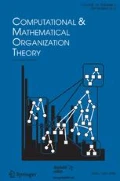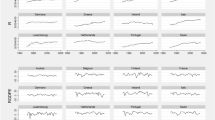Abstract
Competitiveness, defined as the rate of success in attracting and maintaining industries to foster the sustained improvement in citizens’ wellbeing, has been a long-pursued goal for regions and nations. Today’s rapid advancements in technology, especially in telecommunications, open challenges for decision and policy makers to generate effective and efficient solutions in a global scenario. In this context, the latest developments in artificial intelligence, machine learning and deep learning open new paths for describing, analyzing, and representing complex phenomena in systemic environments. This paper presents a model using a neural network to predict the behavior of competitive benchmarks using public expenditure variables. The theory of control, in which the neural network approach is based, offers some advantages such as solving the problem while considering the dynamic nature of the phenomenon and allowing control blocks to be implemented in a straightforward method. The present paper establishes a neural network model that links control, administration, and systems theories in a statistically sound approach that connects both sets of variables, opening the path for extensions that allow optimal allocation of resources.





Similar content being viewed by others
References
Alfaro-García VG, Gil-Lafuente AM, Alfaro Calderón GG (2017) A fuzzy approach to a municipality grouping model towards creation of synergies. Comput Math Organ Theory 23:391–408
Alpaydin E (2014) Introduction to machine learning. MIT Press, Cambridge
Anderson D, Mcneill G (1992) Artificial neural networks technology. Rome Laboratory, New York
Annoni P, Dijkstra L (2019) The EU regional competitiveness index 2019. Publications Office of the European Union, Luxembourg
Auzina-Emsina A (2014) Labour productivity, economic growth and global competitiveness in post-crisis period. Procedia Soc Behav Sci 156:317–321
Benzaquen J, del Carpio LA, Zegarra LA, Valdivia CA (2010) Un índice regional de competitividad para un país (In spanish). Revista CEPAL 102:69
Bernal Huber G, Lagarda Mungaray A (2017) Competitiveness indices in Mexico. Gestión y política pública 26:167–218
Camagni R (2002) On the concept of territorial competitiveness: sound or misleading? Urban Stud 39(13):2395–2411
Caruso L (2018) Digital innovation and the fourth industrial revolution: epochal social changes? AI Soc 33:379–392
Cavazzuti M (2015) Optimization methods: from theory to design scientific and technological aspects un mechanics. Springer-Verlag, Berlin
Chalfin A, Danieli O, Hillis A et al (2016) Productivity and selection of human capital with machine learning. Am Econ Rev 106(5):124–127
Cheng B, Titterington DM (1994) Neural networks: a review from a statistical perspective. Stat Sci 9(1):2–30
Chudnovsky D, Porta F (1990) La competitividad internacional: principales cuestiones conceptuales y metodológicas (In Spanish). CENIT, Buenos Aires
Claveria O, Monte E, Torra S (2016) Combination forecasts of tourism demand with machine learning models. Appl Econ Lett 23(6):428–431
Deo RC (2015) Machine learning in medicine. Circulation 132(20):1920–1930
Drath R, Horch A (2014) Industrie 4.0: hit or hype? IEEE Ind Electron Mag 8(2):56–58
Galushkin A (2007) Neural networks theory. Springer-Verlag, Berlin
Gardiner B, Martin R, Tyler P (2004) Competitiveness, productivity and economic growth across the European regions. Reg Stud 38(9):1045–1067
Garduño Rivera R, Ibarra Olivo JE, Dávila Bugarín R (2013) La medición de la competitividad en México: Ventajas y desventajas de los indicadores (In spanish). Real Datos y Espac 4(3):28–53
Giordano F, La Rocca M, Perna C (2007) Forecasting nonlinear time series with neural network sieve bootstrap. Comput Stat Data Anal 51(8):3871–3884
Gründler K, Krieger T (2016) Democracy and growth: evidence from a machine learning indicator. Eur J Polit Econ 45:85–107
Gu W, Yan B (2017) Productivity growth and international competitiveness. Rev Income Wealth 63(S1):S113–S133
Hagan MT, Demuth HB, Beale MH (2014) Neural network design. Martin Hagan, Oklahoma
Harvey RL (1994) Neural network principles. Prentice Hall International, New Jersey
Hindman M (2015) Building better models. Ann Am Acad Pol Soc Sci 659(1):48–62
Huggins R (2003) Creating a UK competitiveness index: regional and local benchmarking. Reg Stud 37(1):89–96
IMCO (2018) Índice de Competitividad Estatal (In Spanish). Instituto Mexicano para Competitividad, Mexico City
INEGI (2016) Síntesis metodológica de la estadística de finanzas públicas estatales y municipales, 7th edn (In Spanish). Instituto Nacional de Estadística y Geografía, Mexico City
INEGI (2018) Finanzas públicas estatales y municipales (In Spanish). In: Regist. Adm. - Estadísticas. https://www.inegi.org.mx/programas/finanzas/default.html#Datos_abiertos. Accessed 15 Apr 2020
Ivanova E, Kordos M (2017) Competitiveness and innovation performance of regions in Slovak Republic. Mark Manag Innov 1:145–158
Jordan MI, Mitchell TM (2015) Machine learning: trends, perspectives, and prospects. Science 349(6345):255–260
Khashei M, Bijari M (2010) An artificial neural network (p, d, q) model for time series forecasting. Expert Syst Appl 37(1):479–489
Kiseľáková D, Šofranková B, Onuferová E, Čabinová V (2019) The evaluation of competitive position of EU-28 economies with using global multi-criteria indices. Equilibrium 14(3):441–462
Kitson M, Martin R, Tyler P (2004) Regional competitiveness: an elusive yet key concept? Reg Stud 38(9):991–999
Kotsiantis SB, Zaharakis ID, Pintelas PE (2006) Machine learning: a review of classification and combining techniques. Artif Intell Rev 26:159–190
Kou G, Chao X, Peng Y et al (2019) Machine learning methods for systemic risk analysis in financial sectors. Technol Econ Dev Econ 25(5):716–742
Kristjánsdóttir H (2017) Country competitiveness: an empirical study. Balt Reg 9(2):31–44
Lapedes AS, Farber R (1987) Nonlinear signal processing using neural networks: prediction and system modelling. Los Alamos National Laboratory, Los Alamos
Lhéritier A, Bocamazo M, Delahaye T, Acuna-Agost R (2019) Airline itinerary choice modeling using machine learning. J Choice Model 31:198–209
Li G, Hou Y, Wu A (2017) Fourth Industrial Revolution: technological drivers, impacts and coping methods. Chin Geogr Sci 27:626–637
Liu C (2017) International competitiveness and the fourth industrial revolution. Entrep Bus Econ Rev 5(4):111–133
Lu Y (2017) Industry 4.0: a survey on technologies, applications and open research issues. J Ind Inf Integr 6:1–10
Morrar R, Arman H (2017) The fourth industrial revolution (industry 4.0): a social innovation perspective. Technol Innov Manag Rev 7(11):12–20
Mosterman PJ, Zander J (2016) Industry 4.0 as a cyber-physical system study. Softw Syst Model 15:17–29
Nonaka I, Kodama M, Hirose A, Kohlbacher F (2014) Dynamic fractal organizations for promoting knowledge-based transformation: a new paradigm for organizational theory. Eur Manag J 32(1):137–146
Onyusheva I (2017) Analytical and managerial issues of human capital in conditions of global competitiveness: the case of Kazakhstan. Pol J Manag Stud 16(2):198–209
Ordóñez de Pablos P, Lytras M (2018) Knowledge management, innovation and Big Data: implications for sustainability, policy making and competitiveness. Sustainability 10(6):2073
Paliwal M, Kumar UA (2009) Neural networks and statistical techniques: a review of applications. Expert Syst Appl 36(1):2–17
Parveen F, Jaafar NI, Ainin S (2016) Social media’s impact on organizational performance and entrepreneurial orientation in organizations. Manag Decis 54(9):2208–2234
Porter ME (1990) The competitive advantage of nations. Palgrave Macmillan, London
Porter ME (1997) Competitive Strategy. Meas Bus Excell 1(2):12–17
Ramzaev VM, Khaimovich IN, Chumak VG (2016) Use of big data technology in public and municipal management. In: Proceedings of international conference information technology and nanotechnology (ITNT-2016). Samara State Aerospace University, Image Processing Systems Institute, Russian Academy of Sciences, pp 864–872
Ricardo D (1817) On the principles of political economy and taxation. John Murray, London
Rusu VD, Roman A (2018) An empirical analysis of factors affecting competitiveness of C.E.E. countries. Econ Res Istraživanja 31(1):2044–2059
Sachpazidu-Wójcicka K (2017) Innovation as a determinant of the competitiveness of Polish enterprises. Oeconomia Copernicana 8(2):287–299
Sarle WS (1994) Neural networks and statistical models. In: Proceedings of the nineteenth annual SAS Users Group international conference, Cary, USA
Schwab K (2019) The global competitiveness report 2019. World Economic Forum, Cologny
Smith A (1776) An inquiry into the nature and causes of the wealth of nations. W. Strahan and T. Cadell, London
Tadeusiewicz R (2015) Neural networks in mining sciences—general overview and some representative examples. Arch Min Sci 60(4):971–984
Torres-Hernández Z (2008) Teoría general de la administración (In spanish). Grupo Editorial Patria, México
Unger K, Flores D, Ibarra JE (2014) Productivity and human capital complementary sources of the competitiveness in the states in Mexico. Trimest Econ 81(324):909–941
Vecchio P, Mele G, Ndou V, Secundo G (2018) Creating value from social big data: implications for smart tourism destinations. Inf Process Manag 54(5):847–860
von Bertalanffy L (2009) Teoría general de los sistemas: Fundamentos, desarrollo y aplicaciones (In spanish). Fondo de Cultura Económica, México
Wang J, Athanasopoulos G, Hyndman RJ, Wang S (2018) Crude oil price forecasting based on internet concern using an extreme learning machine. Int J Forecast 34(4):665–677
WEF (2020) How much data is generated each day? In: Agenda 2019. https://www.weforum.org/agenda/2019/04/how-much-data-is-generated-each-day-cf4bddf29f/. Accessed 14 Jul 2020
Weresa MA (2019) Technological competitiveness of the EU member states in the era of the fourth industrial revolution. Econ Bus Rev 5(3):50–71
Wuest T, Weimer D, Irgens C, Thoben K-D (2016) Machine learning in manufacturing: advantages, challenges, and applications. Prod Manuf Res 4(1):23–45
Yu C, Zhang Z, Lin C, Wu Y (2017) Knowledge creation process and sustainable competitive advantage: the role of technological innovation capabilities. Sustainability 9:2280
Ženka J, Novotný J, Csank P (2014) Regional competitiveness in Central European countries: in search of a useful conceptual framework. Eur Plan Stud 22(1):164–183
Zuti B (2018) Digitalization and regional competitiveness: a brief summary. University of Szeged, Szeged
Acknowledgements
The First and second author would like to thank the Mexican Council of Science and Technology (CONACyT) for the support given through the Scholarships Number 477685 and 740762. The authors would also like thank all the valuable comments of the reviewers that helped improving the ideas presented in this paper.
Author information
Authors and Affiliations
Corresponding author
Additional information
Publisher's Note
Springer Nature remains neutral with regard to jurisdictional claims in published maps and institutional affiliations.
Rights and permissions
About this article
Cite this article
Zaragoza-Ibarra, A., Alfaro-Calderón, G.G., Alfaro-García, V.G. et al. A machine learning model of national competitiveness with regional statistics of public expenditure. Comput Math Organ Theory 27, 451–468 (2021). https://doi.org/10.1007/s10588-021-09338-9
Accepted:
Published:
Issue Date:
DOI: https://doi.org/10.1007/s10588-021-09338-9




